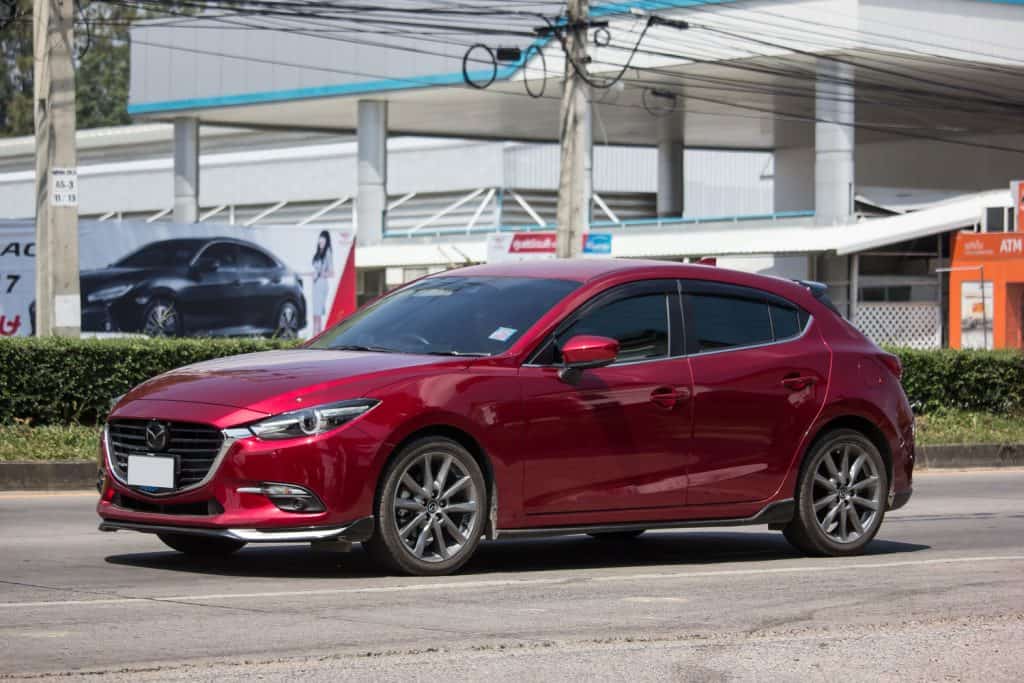Are you considering purchasing a Mazda 3 and would like to know which year model and trims have blind spot monitoring? We combed through data going back almost two decades to bring you the most detailed answer you could possibly find anywhere on the internet.
The Mazda 3 Sedan has blind spot monitoring starting from its 2012 model year. Mazda 3 Hatchback also started to offer blind spot monitoring from its 2012 model year. MazdaSpeed 3 also offered blind spot monitoring starting with its 2012 model year.
However, each of the Mazda 3 model versions has trims with varying features that may or may not include blind spot monitoring. And the features of these trims change almost every year. But worry not, the succeeding sections dive deep into the differences of each model version, model year, and each trim. Read on!
![A red 2021 Mazda 3 at the dealership, Does Mazda 3 Have Blind Spot Monitoring? [By Year And Trim Level]](https://vehq.com/wp-content/uploads/2022/02/Does-Mazda-3-Have-Blind-Spot-Monitoring-By-Year-And-Trim-Level-1-683x1024.png)
Does Mazda have Blind Spot Monitoring?
Mazda was the very first Japanese automaker that included a blind spot monitoring system in its production cars. Mazda called their system the BSM (Blind Spot Monitoring).
Mazda first introduced BSM on the Mazda CX-9 Grand Touring in 2008.
2012 introduction of BSM to Mazda 3
Mazda started offering BSM as an optional feature for Mazda 3 Sedan i Grand Touring in 2012.
Mazda 3 Hatchback had more trims offering BSM in 2012. Both Mazda 3 Hatchback i Grand Touring and Mazda 3 Hatchback s Grand Touring offer BSM as an optional feature.
MazdaSpeed 3 also started to offer BSM as an optional feature on MazdaSpeed 3 Touring—its only trim.
2013
Mazda 3 Sedan discontinued its Mazda 3 Sedan s Touring trim and replaced it with Mazda 3 Sedan s Grand Touring that offered BSM as a standard feature. Mazda 3 Sedan i Grand Touring started to offer BSM as a standard feature.
Mazda 3 Hatchback discontinued its Mazda 3 Hatchback s Touring leaving it with only three trims versus five for Mazda 3 Sedan. Mazda 3 Hatchback s Grand Touring and Mazda 3 Hatchback i Grand Touring started to offer BSM as a standard feature.
MazdaSpeed 3 Touring still offered BSM only as an optional feature.
2014 to 2015
Mazda 3 Sedan discontinued Mazda 3 Sedan s Grand Touring after just one year and reissued Mazda 3 Sedan s Touring. This time, Mazda 3 Sedan s Touring offered BSM as a standard feature.
Mazda 3 Sedan i Touring started to offer BSM as a standard feature.
Mazda added two trims to the lineup of Mazda 3 Hatchback—Mazda 3 Hatchback i Sport and a reintroduced Mazda 3 Hatchback s Touring. Mazda 3 Hatchback s Touring came pre-equipped with BSM. Additionally, Mazda 3 Hatchback i Touring started to include BSM in its standard features.
Mazda discontinued all trims and models of Mazda Speed 3 in 2014.
2016
The Mazda 3 Sedan i Sport started to offer BSM as an optional feature. This marks the first and only time that Mazda 3 Sedan i Sport would offer BSM. It would also be the last year of the Mazda 3 Sedan i Sport.
Mazda discontinued the Mazda 3 Sedan i SV trim, then resurrected Mazda 3 Sedan s Grand Touring with BSM as a standard feature. 2016 marks the first year that all five trims of Mazda 3 Sedan offered BSM albeit it is only an optional feature on the Mazda 3 Sedan i Sport.
Mazda 3 Hatchback i Sport followed suit and started to offer BSM as an optional feature. This is also the first year that all trims of Mazda 3 Hatchback offered BSM—making 2016 the only year where all Mazda 3 trims across two model versions had BSM on offer.
Major changes in 2017 going to 2018
Mazda did a facelift on its third generation Mazda 3 Sedan and Mazda 3 Hatchback for the US market in 2017. To symbolize this change, it dropped the “i” and “s” in its trim names. It discontinued all previous trims for Mazda 3 Sedan and Mazda 3 Hatchback.
For Mazda 3 Sedan, it introduced Mazda 3 Sedan Sport as the cheapest trim that came with an optional BSM feature. Mazda also introduced the Mazda 3 Sedan Touring and Mazda 3 Sedan Grand Touring that came with standard BSM.
Mazda replaced the discontinued Mazda 3 Hatchback trims with four new trims instead of just three like in the Mazda 3 Sedan models.
Mazda 3 Hatchback Touring, Mazda 3 Hatchback Grand Touring, and Mazda 3 Hatchback Touring 2.5 included BSM as a standard feature. Mazda 3 Hatchback Sport did not offer BSM even as an optional feature.
Mazda 3 Hatchback Touring 2.5 was discontinued in 2018.
2019 and the 4th-generation Mazda 3

Mazda introduced the fourth generation of Mazda 3 in 2019. With its arrival, it dropped all previous trims for Mazda 3 Sedan and Mazda 3 Hatchback.
Mazda introduced four new trims for Mazda 3 Sedan. Mazda 3 Sedan Select, Mazda 3 Sedan Preferred, and Mazda 3 Sedan Premium were all released with BSM as a standard feature. Only the cheapest Mazda 3 Sedan trim did not offer a BSM of any kind.
Mazda released three trims for the hatchback model version. Mazda 3 Hatchback Preferred, Mazda 3 Hatchback Premium, Mazda 3 Hatchback Standard all came with BSM as a standard feature.
The changes to Mazda 3 Sedan and Mazda 3 Hatchback continued until 2020.
2021

Mazda discontinued Mazda 3 Sedan Standard and replaced it with two new trims. The Mazda 3 2.0 Sedan and the Mazda 3 Sedan 2.5 S. Both did not offer BSM even as an optional feature.
Mazda discontinued the Mazda 3 Hatchback Standard and replaced it with three new trims. The Mazda 3 Hatchback Select and the Mazda 3 Hatchback 2.5 Turbo were released with BSM as a standard feature. The Mazda 3 Hatchback 2.5 S did not offer a BSM even as an option, just like its sedan counterpart.
2022
Mazda discontinued two sedan trims and replaced them with two new trims. On the hatchback side, one trim was discontinued and was replaced with a hatchback version of one of the sedan’s new trim.
Mazda 3 Sedan Premium and Mazda 3 2.0 Sedan were discontinued. Mazda 3 Sedan 2.0 was introduced without any form of BSM.
Mazda 3 Sedan Carbon Edition was introduced with BSM as a standard feature.
The Mazda 3 Hatchback 2.5 Turbo was discontinued and was replaced with the Mazda 3 Hatchback Carbon Edition that offered BSM as a standard feature.
How much does a blind monitoring system cost?
Do you have a first- or second-generation Mazda 3, and you’re wondering how much it would take to install an aftermarket blind monitoring system on these models?
A blind monitoring system has two main components. The first component is responsible for detecting the presence of cars on blind spots. The second component is responsible for getting the driver’s attention and notifying them of any approaching cars.
The most affordable aftermarket blind monitoring systems cost around $250. However, these systems are severely limited in functionality and sometimes even accuracy. These systems include a few sensors and only the very basic indicator technology.
The midrange price of blind spot monitoring systems is in the $500 range. These systems have better accuracy, although they are still less accurate than factory-installed blind spot monitoring systems.
The most accurate aftermarket blind spot monitoring systems use advanced algorithms that greatly reduce the possibility of false triggers. Additionally, sensor accuracy is high. These systems cost more than $500.
If you're looking for an aftermarket blind side monitoring system, check out the Easyguard EBS001 car blind area detection system. See it on Amazon.
Where are the BSM sensors on a Mazda 3?
Now that we’re done talking about each year's model versions, and trims that offered BSM either as a standard feature or option, isn’t it interesting to know where the BSM sensors are installed?
There are two radar sensors installed on both the Mazda 3 Sedan and Mazda 3 Hatchback model versions. They are located on the rear bumper, with one radar sensor on each side.
Why is my blind spot monitoring system unable to detect vehicles?
The BSM system needs to meet certain conditions before they alert the driver even though there is a vehicle within the monitored area of your Mazda 3.
The following are some of the conditions that can cause the blind spot monitoring system to ignore a vehicle.
- The vehicle within the detection area is not approaching your Mazda 3.
- The vehicle driving alongside your Mazda 3 is moving at a similar speed.
- The vehicle within the detection area is traveling in the opposite direction.
- The vehicle is driving in an extremely wide adjacent lane.
- The vehicle’s speed is below six miles per hour.
- There is a high difference in speed with vehicles in the monitored area.
- The vehicle is small, like motorcycles or vehicles with a very low height.
- Your Mazda 3’s speed is slower than seven miles per hour.
How do you turn on the blind monitoring system in Mazda 2019?

Your BSM system is off when you see the light that says “BSM Off” in your dashboard instrumentation cluster.
Look for the BSM switch to turn it on. Once it turns on, the “BSM Off” light will go away.
How to adjust BSM alert volume?
The BSM alert volume can be changed from the home screen.
- Go to “Settings” on the home screen.
- Choose the “Safety” tab.
- Select “Blind Spot Monitoring System.”
- Adjust the volume accordingly based on your preference.
You can choose to turn off the volume of the alert. This will mute the beeping alert, but the light signals will still be active. They will light up and signal you as normal when there is a vehicle on the blind side of your Mazda 3.
The Ampper 2" Blind Spot Mirror can show you objects near the vehicle. See it on Amazon.
Conclusion
The blind side monitoring system is an important safety feature that can prevent inattentive drivers from changing lanes into an oncoming car.
Knowing which year model, version, and trim have blind side monitoring is important to know before purchasing a Mazda 3.
If you found this article interesting, then you’d definitely enjoy reading the following:


